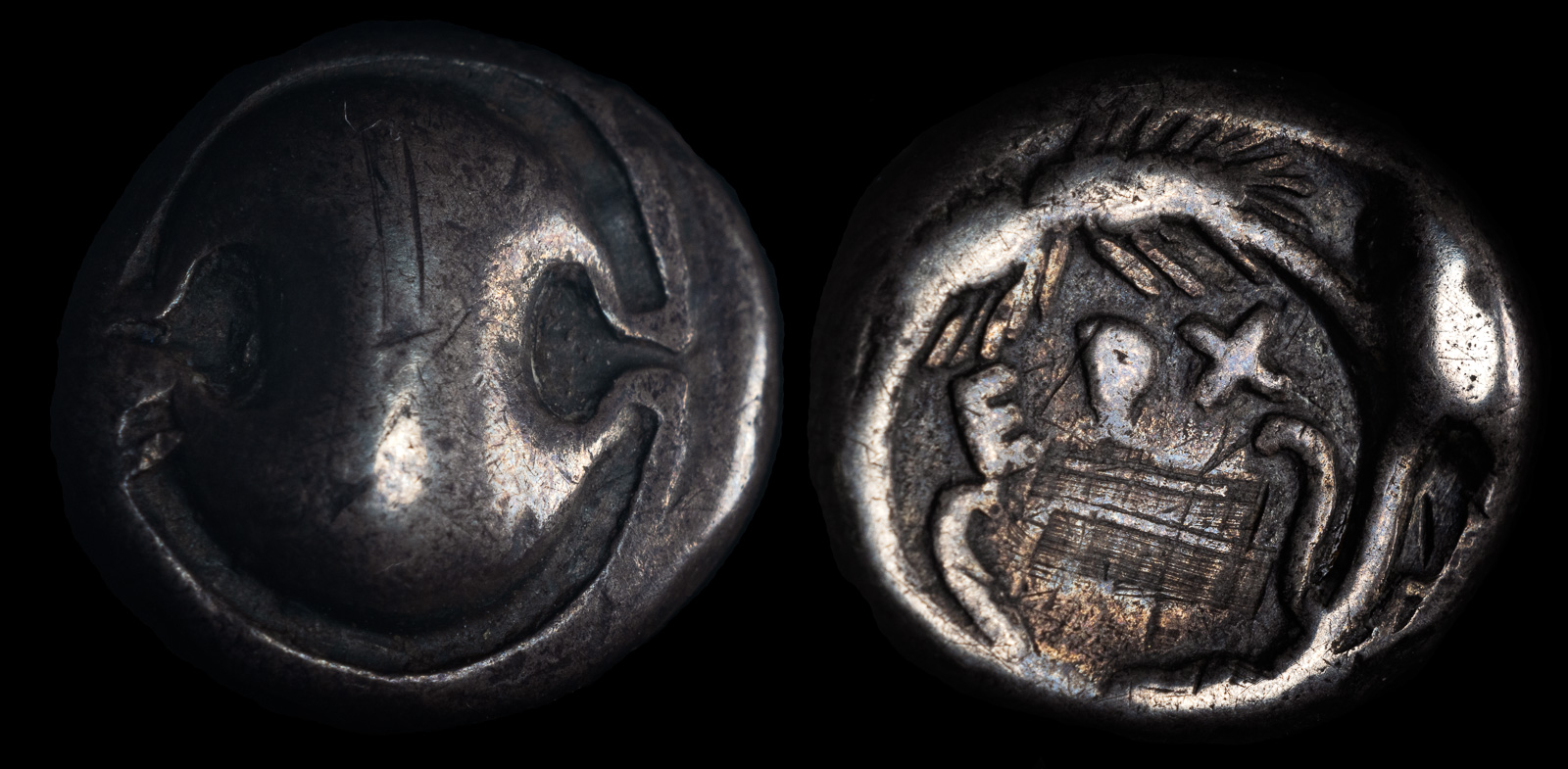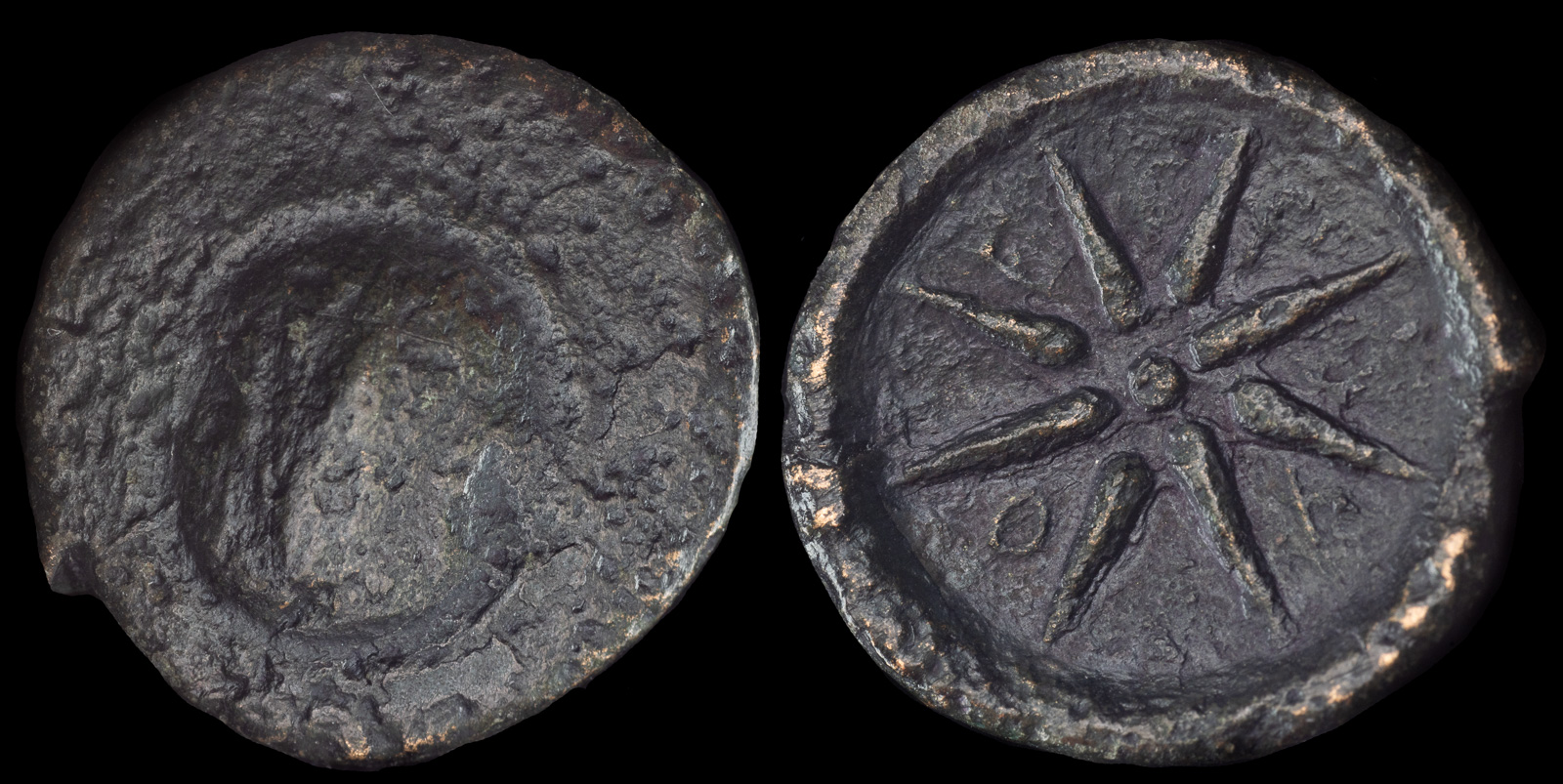
Boeotia, Orchomenos
Circa 395-364 BCE
AR Hemidrachm 13 mm, 2.49 g
Boeotian shield.
Rev. EPX in wreath of grain.
BCD Boiotia 220. HGC 4, 1239. McClean 5537. SNG Copenhagen 200
ex CNG 2022
Ex CNG 2012
Ex BCD Collection
Ex CNG 2006
Ex Burgan MBS 1983
Orchomenos was perhaps the second leading city (distantly) in Boeotia after Thebes. In mythology, the city was founded by Minyas, who was believed to be a son of Poseidon. He was also the father of the Minyans, the people who originally settled around Orchomenos.
The city exited during Mycenaean times, but was burned and destroyed like the rest of Greece at the end of that era.
In ancient times, Orchomenos was best known for its Sanctuary of the Charites and for its Agrionia festival. The Charites, also known as the Graces, were three or more goddesses that typically personified female attributes and were often depicted in sculptures and paintings. The Agrionia was a strange festival during which a man dressed as Dionysos chased a woman and actually killed her. It therefore practiced human sacrifice, but per Plutarch was eventually ceased.
The Battle of Chaeronea, where Philip II defeated Thebes and Athens and thus achieved supremacy over Greece, was fought near Orchomenos.

Boeotia, Orchomenos
circa 371-364 BCE
Ae 14,5mm 2,60g
Obv: Boeotian shield, decorated with grain ear.
Rev: E – P – X – O. Eight-pointed star around central pellet.
BCD Boiotia 225; HGC 4, 1260

Kings of Macedon Alexander the Great
336-323 BCE
AE 16.35mm 4.27g
Obv: Young male head wearing diadem right
Rev: ALEXANDROY. Horse galloping right, Boetian Shield below
Price 351
What struck me was the shield just under the galloping horse on the reverse. From its shape and form, it’s clearly Boeotian, and pretty much every attribution agrees. That led me to wonder why a coin with such a mark would be minted.
Price attributed this to Alexander’s lifetime, but I unfortunately don’t have the text to know if he said anything more about this type. From the type, it appears that this could have been minted posthumous as well, but perhaps there have been finds to allow more precise dating.
Regardless of the date range, though no specific mint has been given, it certainly seems to me that the likely culprit would be somewhere in Boeotia. Perhaps there could be some argument that it was minted in Macedonia itself to commemorate Alexander’s victory there, but it seems more plausible to me that it was minted by one of his allies in Boeotia itself. Bronze coins tended to be used primarily locally, and so if the goal was to dissuade other cities from revolting with a subtle reminder of what happened to Thebes, it would have been far more effective in silver.
Of the Boeotian cities, I highly doubt this was Thebes. First, the city was annihilated by Alexander, so no coins were minted through most of his rule. It was only Kassander who ordered its reconstruction in 316 BCE. That’s also the time Kassander started minting his own coins. Therefore, I’m not buying that Thebes would mint a coin with the name of the guy who destroyed their city, especially when they were ruled by someone who hated him. While I would love to say that the male image on the obverse is of Kassander himself and the coin depicted him raising the kingdom from Alexander’s ruin, I just don’t see that. A far simpler solution appears better.
Instead, I think this may be an issue of Orchomenos. Per Arrian, they were the most zealous allies of Alexander and gleefully took part in the carnage.
Then indeed the Thebans, no longer defending themselves, were slain, not so much by the Macedonians as by the Phocians, Plataeans and other Boeotians, who by indiscriminate slaughter vented their rage against them. Some were even attacked in the houses (a few of whom turned to defend themselves), and others as they were supplicating the protection of the gods in the sanctuaries; not even the women and children being spared.
Orchomenos itself was destroyed by Thebes in 364 BCE, then rebuilt by the Phokians in 355 BCE and again destroyed by Thebes in 349 BCE. Thus, there was some built-up animosity. After annihilating Thebes, Alexander ordered the reconstruction of Orchomenos.
The settlement of Theban affairs was entrusted by Alexander to the allies who had taken part in the action. They resolved to occupy the Cadmea with a garrison; to raze the city to the ground; to distribute among themselves all the territory, except what was dedicated to the gods; and to sell into slavery the women and children, and as many of the males as survived, except those who were priests or priestesses, and those who were bound to Philip or Alexander by the ties of hospitality or had been public agents of the Macedonians. It is said that Alexander preserved the house and the descendants of Pindar the poet, out of respect for his memory. In addition to these things, the allies decreed that Orchomenus and Plataea should be rebuilt and fortified.
It therefore seems natural to me that, once rebuilt, Orchomenos would have minted bronzes in Alexander’s name along with their own Boeotian shield.
Orchomenos is burned and its palace destroyed.
Orchomenos joins the Boeotian League, headed by Thebes.
The Boeotian League, headed by Thebes, sacks Orchomenos.
Orchomenos is rebuilt with the help of Phokis.
Orchomenos is destroyed again by Thebes.
Alexander the Great demolishes Thebes after a rebellion. Perdikkas is severely wounded in the battle. Orchomenos and Thespiai fight on the side of Alexander.
Orchomenos is rebuilt with the help of Alexander III.
Sulla destroys Larymna after a victory at Orchomenos.